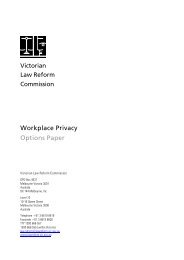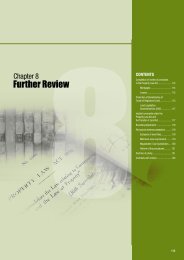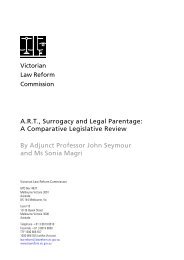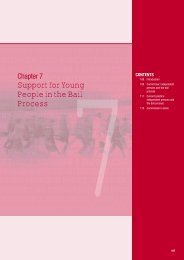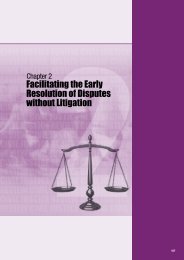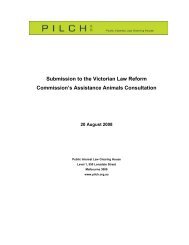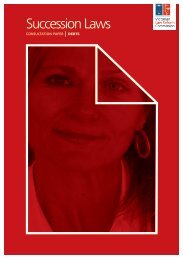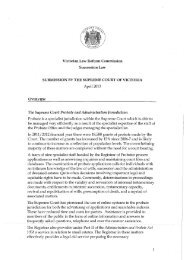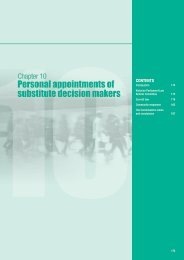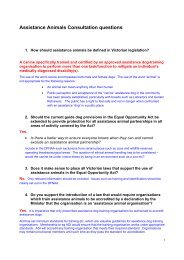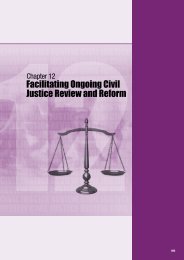Medical research - Victorian Law Reform Commission
Medical research - Victorian Law Reform Commission
Medical research - Victorian Law Reform Commission
You also want an ePaper? Increase the reach of your titles
YUMPU automatically turns print PDFs into web optimized ePapers that Google loves.
14.8 A ‘medical <strong>research</strong> procedure’ is defined in the current Act as:<br />
A procedure carried out for the purposes of medical <strong>research</strong>, including, as part<br />
of a clinical trial, the administration of medication or the use of equipment or a<br />
device… 3<br />
14.9 The Act specifically excludes some procedures from its definition of a ‘medical <strong>research</strong><br />
procedure’, such as a non-intrusive examination (including a visual examination of the<br />
mouth, throat, nasal cavity, eyes or ears or the measuring of a person’s height, weight<br />
or vision), observing a person’s activities, undertaking a survey, or collecting or using<br />
information including personal or health information. 4<br />
14.10 The G&A Act establishes a four-step process for authorising a person’s participation<br />
in a medical <strong>research</strong> procedure where they are unable to consent to that procedure.<br />
Those steps are:<br />
• Step 1: determine whether the <strong>research</strong> project is approved by the ‘relevant<br />
human <strong>research</strong> ethics committee’. 5 Approval of the project is required before the<br />
medical <strong>research</strong> procedure may be carried out and the procedure must be carried<br />
out in accordance with any conditions of the approval.<br />
• Step 2: determine whether the patient is likely to be able to consent to the<br />
<strong>research</strong> procedure within a reasonable time. If this is likely, then the <strong>research</strong><br />
procedure should not go ahead until the patient is able to consent to it. 6 If the<br />
patient is not likely to be able to consent within a reasonable time, Step 3 applies.<br />
• Step 3: obtain the consent of the ‘person responsible’. 7 The person responsible<br />
can consent to the procedure if they believe that it would not be contrary to the<br />
patient’s best interests. 8 If it is not possible to comply with this step because the<br />
person responsible is not available, Step 4 applies.<br />
• Step 4: ‘procedural authorisation’ applies when the person responsible cannot be<br />
identified or contacted. It allows a registered practitioner to carry out the <strong>research</strong><br />
procedure if the practitioner certifies that a number of things have been done and<br />
that the practitioner holds a number of beliefs about the <strong>research</strong> project and the<br />
person concerned. The practitioner must hold particular beliefs about:<br />
– the best interests of the patient<br />
– whether the ethics committee was aware that the <strong>research</strong> might involve<br />
people who are unable to consent<br />
– whether the procedure adds to risks the patient faces because of their<br />
medical condition<br />
– whether there is a reasonable scientific likelihood that the patient will benefit<br />
from the <strong>research</strong> procedure. 9<br />
14.11 The effect of Step 4 is that the person implementing the <strong>research</strong> procedure becomes<br />
the substitute decision maker for a person who is unable to make a decision about<br />
their own participation if there is no person responsible available to authorise<br />
participation.<br />
3 Guardianship and Administration Act 1986 (Vic) s 3(1). The definition also includes any procedures prescribed by regulations to be medical<br />
<strong>research</strong> procedures. There are no additional procedures in regulations.<br />
4 Guardianship and Administration Act 1986 (Vic) s 3(1).<br />
5 Ibid s 42Q. The term ‘relevant human <strong>research</strong> ethics committee’ is defined in somewhat circular fashion in section 3 of the Act to mean ‘the<br />
human <strong>research</strong> ethics committee responsible for approving the relevant <strong>research</strong> project’.<br />
6 Guardianship and Administration Act 1986 (Vic) s 42R.<br />
7 The appointment and role of the person responsible are discussed in Chapter 13.<br />
8 Guardianship and Administration Act 1986 (Vic) s 42S.<br />
9 Ibid s 42T.<br />
305



